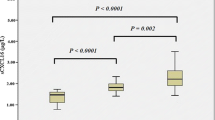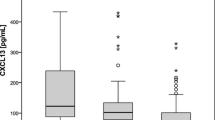Abstract
The aim of this study is to determine serum CCL23 levels and their clinical associations in patients with systemic sclerosis (SSc). Serum CCL23 levels were examined by ELISA in 66 patients with SSc, 20 patients with systemic lupus erythematosus, 20 patients with dermatomyositis, and 33 healthy individuals. Serum CCL23 levels were elevated in SSc patients (389.1 ± 199.2 pg/mL) compared with healthy individuals (94.1 ± 85.6 pg/mL; P < 0.001) and patients with systemic lupus erythematosus (43.4 ± 39.3 pg/mL; P < 0.001) or dermatomyositis (132.1 ± 104.5 pg/mL; P < 0.001). Among SSc patients, there were no differences in serum CCL23 levels between those with limited cutaneous SSc and those with diffuse cutaneous SSc. SSc patients with elevated CCL23 levels were found to have shorter disease duration than those with normal CCL23 levels (P < 0.001). Furthermore, raised CCL23 levels were associated with a higher frequency of pulmonary arterial hypertension (P < 0.05). The results show that serum CCL23 level was increased in the early phase of SSc. CCL23 could be associated with induction of SSc and as such would be a serologically useful marker for disease activity.



Similar content being viewed by others
References
Berahovich RD, Miao Z, Wang Y, Premack B, Howard MC, Schall TJ (2005) Proteolytic activation of alternative CCR1 ligands in inflammation. J Immunol 174:7341–7351
Bohan A, Peter JB (1975) Polymyositis and dermatomyositis (first of two parts). N Engl J Med 292:344–348
Clements PJ, Lachenbruch PA, Seibold JR et al (1993) Skin thickness score in systemic sclerosis: an assessment of interobeservar variability in 3 independent studies. J Rheumatol 20:1892–1896
Famularo G, Procopio A, Giacomelli R et al (1990) Soluble interleukin-2 receptor, interleukin-2 and interleukin-4 in sera and supernatants from patients with progressive systemic sclerosis. Clin Exp Immunol 81:368–372
Fleischmajer R, Perlish JS, Reeves JRT (1977) Cellular infiltrates in scleroderma skin. Arthritis Rheum 20:975–984
Grassegger A, Schuler G, Hessenberger G et al (1998) Interferon-gamma in the treatment of systemic sclerosis: a randomized controlled multicentre trial. Br J Dermatol 139:639–648
Han KY, Kim CW, Lee TH, Son Y, Kim J (2009) CCL23 up-regulates expression of KDR/Flk-1 and potentiates VEGF-induced proliferation and migration of human endothelial cells. Biochem Biophys Res Commun 382:124–128
Hasegawa M, Fujimoto M, Kikuchi K, Takehara K (1997) Elevated serum levels of interleukin 4 (IL-4), IL-10, and IL-13 in patients with systemic sclerosis. J Rheumatol 24:328–332
Hwang J, Son KN, Kim CW et al (2005) Human CC chemokine CCL23, a ligand for CCR1, induces endothelial cell migration and promotes angiogenesis. Cytokine 30:254–263
LeRoy EC, Krieg T, Black C et al (1988) Scleroderma (systemic sclerosis): classification, subsets, and pathogenesis. J Rheumatol 15:202–205
Matsushita T, Hasegawa M, Hamaguchi Y, Takehara K, Sato S (2006) Longitudinal analysis of serum cytokine concentrations in systemic sclerosis: association of interleukin 12 elevation with spontaneous regression of skin sclerosis. J Rheumatol 33:275–284
Molteni M, Della Bella S, Mascagni B et al (1999) Increased interferon-gamma (IFN-γ) levels produced in vitro by alloactivated T lymphocytes in systemic sclerosis and Raynaud’s phenomenon. Clin Exp Immunol 116:164–168
Nardelli B, Morahan DK, Bong GW, Semenuk MA, Kreider BL, Garotta G (1999) Dendritic cells and MPIF-1: chemotactic activity and inhibition of endogenous chemokine production by IFN-gamma and CD40 ligation. J Leukoc Biol 65:822–828
Nardelli B, Tiffany HL, Bong GW et al (1999) Characterization of the signal transduction pathway activated in human monocytes and dendritic cells by MPIF-1, a specific ligand for CC chemokine receptor 1. J Immunol 162:435–444
Needleman BW, Wigley FM, Stair RW (1992) Interleukin-1, interleukin-2, interleukin-4, interleukin-6, tumor necrosis factor-α, and interferon-γ levels in sera from patients with scleroderma. Arthritis Rheum 35:67–72
Novak H, Muller A, Harrer N, Gunther C, Carballido JM, Woisetschlager M (2007) CCL23 expression is induced by IL-4 in a STAT6-dependent fashion. J Immunol 178:4335–4341
Rioja I, Hughes FJ, Sharp CH et al (2008) Potential novel biomarkers of disease activity in rheumatoid arthritis patients: CXCL13, CCL23, transforming growth factor alpha, tumor necrosis factor receptor superfamily member 9, and macrophage colony-stimulating factor. Arthritis Rheum 58:2257–2267
Roumm AD, Whiteside TL, Medsger TA Jr, Rodnan GP (1984) Lymphocytes in the skin of patients with progressive systemic sclerosis. Quantification, subtyping, and clinical correlations. Arthritis Rheum 27:645–653
Sato S, Ihn H, Kikuchi K, Takehara K (1994) Antihistone antibodies in systemic sclerosis: association with pulmonary fibrosis. Arthritis Rheum 37:391–394
Scharffetter K, Lankat-Buttgereit B, Krieg T (1988) Localization of collagen mRNA in normal and scleroderma skin by in situ hybridization. Eur J Clin Invest 18:9–17
Son KN, Hwang J, Kwon BS, Kim J (2005) Human CC chemokine CCL23 enhances expression of matrix metalloproteinase-2 and invasion of vascular endothelial cells. Biochem Biophys Res Commun 340:498–504
Steen VD, Medsger TA Jr (2000) Severe organ involvement in systemic sclerosis with diffuse scleroderma. Arthritis Rheum 43:2437–2444
Steen VD, Powell DL, Medsger TAJ (1988) Clinical correlations and prognosis based on serum autoantibodies in patients with systemic sclerosis. Arthritis Rheum 31:196–203
Subcommittee for scleroderma criteria of the American Rheumatism Association Diagnostic and Therapeutic Criteria Committee (1980) Preliminary criteria for the classification of systemic sclerosis (scleroderma). Arthritis Rheum 23:581–590
Tan EM, Cohen AS, Fries JF et al (1982) The 1982 revised criteria for the classification of systemic lupus erythematosus. Arthritis Rheum 25:1271–1277
Valentini G, Della Rossa A, Bombardieri S et al (2001) European multicentre study to define disease activity criteria for systemic sclerosis II. Identification of disease activity variables and development of preliminary activity indexes. Ann Rheum Dis 60:592–598
White B (1996) Immunopathogenesis of systemic sclerosis. Rheum Dis Clin North Am 32:695–708
Acknowledgments
The authors have expressed no conflicts of interest. This work was supported by a grant of Research on Intractable Diseases from the Ministry of Health, Labor and Welfare of Japan.
Author information
Authors and Affiliations
Corresponding author
Rights and permissions
About this article
Cite this article
Yanaba, K., Yoshizaki, A., Muroi, E. et al. Serum CCL23 levels are increased in patients with systemic sclerosis. Arch Dermatol Res 303, 29–34 (2011). https://doi.org/10.1007/s00403-010-1078-8
Received:
Revised:
Accepted:
Published:
Issue Date:
DOI: https://doi.org/10.1007/s00403-010-1078-8




